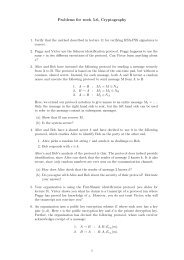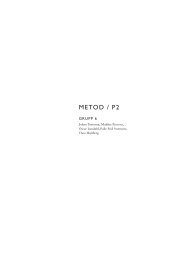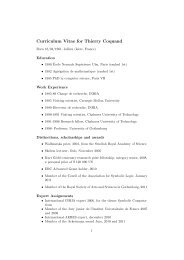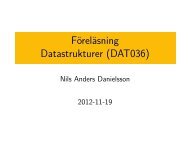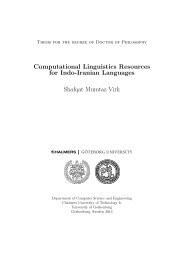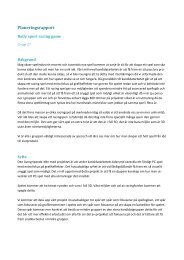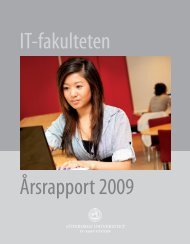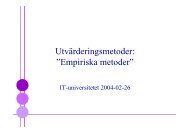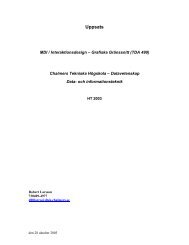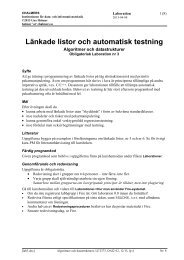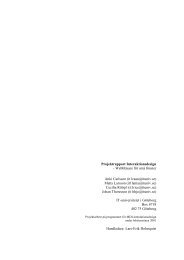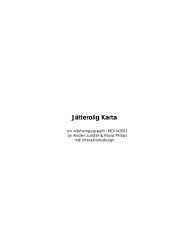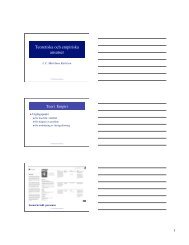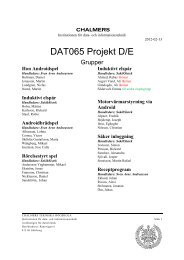GF Russian Resource Library
GF Russian Resource Library
GF Russian Resource Library
Create successful ePaper yourself
Turn your PDF publications into a flip-book with our unique Google optimized e-Paper software.
UseN2 x = x ;<br />
UseN3 x = x ;<br />
The application of a function gives, in the first place, a common noun: kl�q ot<br />
doma (the key from the house). From this, other rules of the resource grammar<br />
give noun phrases, such as kl�qi ot doma (the keys from the house), kl�qi ot<br />
doma i ot maxiny (the keys from the house and the car), and kl�q ot doma<br />
i ot maxiny (the key from the house and the car) (the latter two corresponding<br />
to distributive and collective functions, respectively). Semantics will eventually tell<br />
when each of the readings is meaningful:<br />
ComplN2 mama ivan =<br />
{s = \\n, cas => case ivan.pron of<br />
{ True => ivan.s ! (mkPronForm cas No (Poss (gNum mama.g n)))<br />
++ mama.s ! n ! cas;<br />
False => mama.s ! n ! cas ++ mama.s2 ++<br />
ivan.s ! (mkPronForm mama.c Yes (Poss (gNum mama.g n)))<br />
};<br />
g = mama.g ;<br />
anim = mama.anim<br />
} ;<br />
Two-place functions add one argument place. There application starts by filling the<br />
first place:<br />
ComplN3 poezd paris =<br />
{s = \\n,c => poezd.s ! n ! c ++ poezd.s2 ++ paris.s !<br />
(PF poezd.c Yes NonPoss) ;<br />
g = poezd.g ; anim = poezd.anim;<br />
s2 = poezd.s3; c = poezd.c2<br />
} ;<br />
The two main functions of adjective are in predication (Ivan – molod) [Ivan is<br />
young] and in modification (molodo� qelovek) [a young man]. Predication will be<br />
defined later, in the chapter on verbs:<br />
AdjCN khoroshij novayaMashina =<br />
{s = \\n, c =><br />
khoroshij.s ! AF c novayaMashina.anim<br />
(gNum novayaMashina.g n) ++ novayaMashina.s ! n ! c ;<br />
g = novayaMashina.g ;<br />
anim = novayaMashina.anim<br />
} ;<br />
This is a source of the I saw a man with a telescope-ambiguity, and may produce<br />
strange things, like maxiny vsegda (cars always). Semantics will have to make<br />
finer distinctions among adverbials:<br />
AdvCN chelovek uTelevizora =<br />
{s = \\n,c => chelovek.s ! n ! c ++ uTelevizora.s ;<br />
g = chelovek.g ;<br />
anim = chelovek.anim<br />
} ;<br />
Constructions like idea, qto dva q�tnoe (the idea that two is even) are formed at<br />
the first place as common nouns, so that one can also have predpoloжenie, qto...<br />
(the suggestion that...):<br />
37



